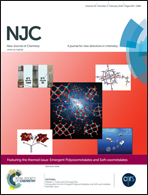Structure–reactivity correlation in selective colorimetric detection of cyanide in solid, organic and aqueous phases using quinone based chemodosimeters†
Abstract
Quinone based colorimetric chemodosimeters, which could instantly detect CN− in solid, organic and aqueous phases with selectivity and sensitivity are described. The results of UV-Vis, fluorescence, 1H and 13C NMR spectroscopy, electrochemical studies and product analysis confirmed that the mechanism of sensing is through nucleophilic addition of CN− to the C![[double bond, length as m-dash]](https://www.rsc.org/images/entities/char_e001.gif) C bond of the indole ring. DFT calculations were conducted to rationalize the sensing mechanism of these sensors. Though the sensors show a different color change with F− in organic medium via H-bond formation, they are highly selective towards CN− as shown in the relay experiment as well as when they are added together. A novel attempt is made to explain the effect of substituents on the sensing behavior by carrying out “Structure–Reactivity Correlation” using Hammett's substituent constants (σp).
C bond of the indole ring. DFT calculations were conducted to rationalize the sensing mechanism of these sensors. Though the sensors show a different color change with F− in organic medium via H-bond formation, they are highly selective towards CN− as shown in the relay experiment as well as when they are added together. A novel attempt is made to explain the effect of substituents on the sensing behavior by carrying out “Structure–Reactivity Correlation” using Hammett's substituent constants (σp).


 Please wait while we load your content...
Please wait while we load your content...